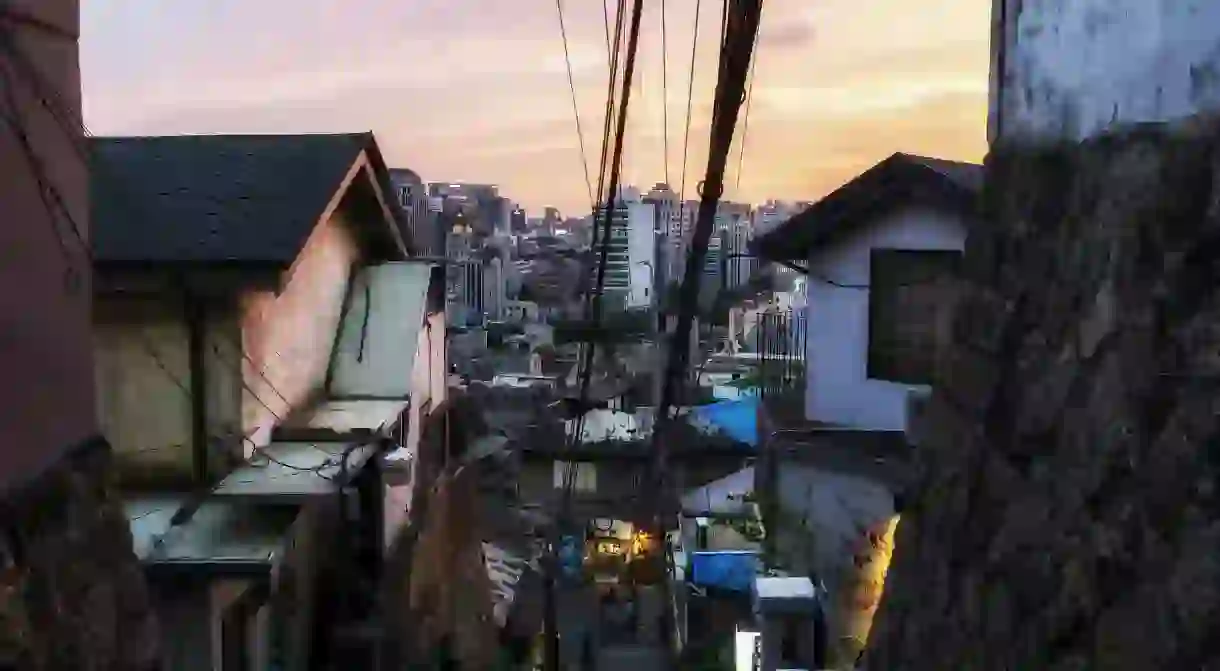How To Explore Ihwa Mural Village, Seoul's Artistic Enclave

Nestled along the peaks of Mt Naksan, Ihwa Village’s rainbow facade gives little away of its troubled past. At the brink of demolition, this little daldongnae was brought back to life by an ambitious art project that would paint the town in a multicolour palette.
Ihwa Mural Village was once what the Koreans would call a daldongnae. Literally translating as moon village, these neighbourhoods were typically located high up on hillsides, offering residents clear views of the moon.
During wartime Korea in the early ’50s, these villages were generally inhabited by refugees who couldn’t afford to live in the more desirable parts of town. Residents lived in slum houses built with whatever came to hand. Food was sparse, and clean water was limited. While these daldongnae offered a perfect vantage point for stargazing, they usually came at the cost of a steep, difficult and oftentimes dangerous climb.

In the five decades following the Korean war, life improved significantly for Seoul residents, even for those living in daldongnae. As the economy recovered, many inhabitants flocked to other parts of Seoul, and a lot of these neighbourhoods emptied out, including Ihwa. The exodus had turned the village into a ghost town. But in 2006, a government initiative changed Ihwa’s fate.
The Ministry of Culture, Sports and Tourism launched the Art in City Project. A collection of over 70 murals started springing up around the city, painted by South Korean artists depicting people, animals and cartoon imagery. Ihwa Mural Village was the first of its kind in Korea, inspiring other cities (most notably Gamcheon Culture Village near Busan) to use art to attract visitors.

These colourful murals helped to reinvigorate Ihwa Village; cafés and shops sprang up shortly after these murals were erected, injecting some much needed income into the local economy. But the transition phase wasn’t easy for locals. They hadn’t been consulted about the murals or the plans to increase tourism to their neighbourhood. And after a few years, many residents began to tire of visitors traipsing past their homes and taking photos.
So extreme was the backlash that a silent campaign saw locals paint over several popular murals in the village, including an image of Koi Carp painted upon a flight of stairs. While many of these images have been replaced, the resistance brought to light the difficulties of modern-day tourism.
For that reason, we’d recommend following these guidelines to ensure you and the locals both enjoy the neighbourhood: don’t open doors or walk through gates uninvited; avoid capturing the locals in your photos; and support the area by making a purchase in a local shop or café.

Angel wings mural, as featured in a popular Korean reality TV show
Architectural Landmark
Ihwa Mural Village’s early success could largely be attributed to the popularity of the Korean reality TV show 2 Days & 1 Night. The pair of angel wings set against a sky-blue background featured in the travel/comedy show, when Lee Seung-gi was shot posing in front of the mural, prompting droves of fans to follow suit.
The staircase to Café Gaeppul
Architectural Landmark
Fans of the K-drama Encounter will recognise the steps leading up to Café Gaeppul. The café features during Kim Jin-Hyuk’s proposal to his girlfriend, Cha Soo-Hyun. But regardless of whether you’re an Encounter fan or not, Café Gaeppul is worth a visit – particularly during the hot and humid summer months. Savour an iced coffee while admiring the views of the city from the balcony.
Father and daughter street art
Architectural Landmark
Another popular piece of street art in Ihwa is the mural of an elderly man and a young girl, painted in a cartoon style by a local artist. It’s one of a collection of murals depicting locals living their ordinary everyday lives. The collection also features other slices of Korean life, like artisans making handicrafts, kids laughing and neighbours gossiping.
Hi Jessie Café
Cafe, Korean
As you climb up the stairs towards Ihwa Mural Village, one of the first cafés you’ll come across is Café Jessie. It’s known for its colourful macarons that are decorated with cute animal designs. Running the gamut from traditional to experimental, their range of flavours include Nutella, pumpkin and strawberry milk.
Naksan Park
Park

Set against some of the most alluring views of the city, Naksan Park is adorned with artistic steel structures depicting everyday life in the village: one is of a couple holding hands, another is of a man walking a dog. After a long day exploring the murals and cafés of Ihwa Mural Village, Naksan Park is the perfect spot to complete the day.













